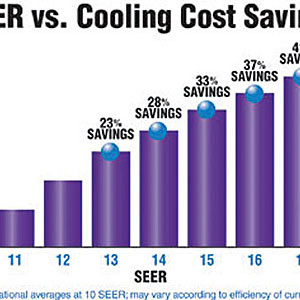One of the challenges HVAC manufacturers have to address when designing new equipment is how to continue raising efficiencies to keep up with increasingly tighter federal requirements.

|
|
Percentage based on national averages at 10 SEER; may vary according to efficiency of current unit and installation.
|
This wasn’t much of a problem back when there were no minimum standards. When the law was passed that required A/C systems to meet at least 10-SEER (Btu/watt) and gas furnaces had to be at least 80% efficient, all manufacturers had to do was add a little space to their coils and heat exchangers.
Then when the requirement for A/C units was set at a 13-SEER minimum, all they had to do was change to more efficient compressors and enhance the coils a bit more. However, from this point on the challenge is getting tougher. Soon, higher minimum efficiencies will be required and there is a finite limit to how efficient A/C units can become.
Added to the pressure on designers and engineers are all the crazy new requirements on refrigerant gases and the challenge of making the systems idiot-proof so the higher efficiencies aren’t lost through poor installation. This needs to be more closely examined and addressed by government regulators.
So where can manufacturers go from here to hit even higher efficiencies?
Well, they already know because almost all manufacturers offer top-end models that are at least a third more efficient than their “builder models.” Once again, better compressor designs are becoming available, and the electronics and better motors are getting cheaper, thus higher efficiencies are being achieved by varying motor speeds to match the system operation to the cooling (or heating) load. However, this all comes at a greater cost to consumers who are finding it increasingly more difficult to afford new systems or even to repair their old systems.
Where can they go beyond that to achieve even higher efficiencies at some future date? To be sure, it will cost the consumers even more, but it can be done!
As I have discussed in previous articles, there are methods other than using a compression cycle to provide cooling, and combining these with existing technology will achieve even higher efficiencies than the compression cycle alone is capable of doing. However, until new physics is discovered, the top efficiencies beyond what I have discussed to this point can only be achieved by improved zoning — heating and cooling only the space where air conditioning is required. And yes, some of the Asian HVAC systems already are there (at least when it comes to zoning).
It’s funny that the Japanese used to call their unique mini-split systems “American air conditioners.” But once you get out of North America, the A/C systems you’ll find throughout the rest of the world look nothing like those designs we use here. No 24-volt thermostats operating large, un-zoned ducted systems!
And maybe that’s because energy is more costly everywhere else, or maybe it’s because we are so slow to change. Yes, everyone else is ahead of us when it comes to the use of metrics, even third-world countries.
The fact is ductless-split systems finally are making some headway here after some 25 years of being in our market. All the American manufacturers are producing and selling them throughout the world, just not in the U.S. as much. But that will change because it will have to.
And the nice thing about these systems is that it is hard to design and install them wrong, so unlike ducted systems they usually meet their rated efficiencies.
HELPFUL LINKS:




